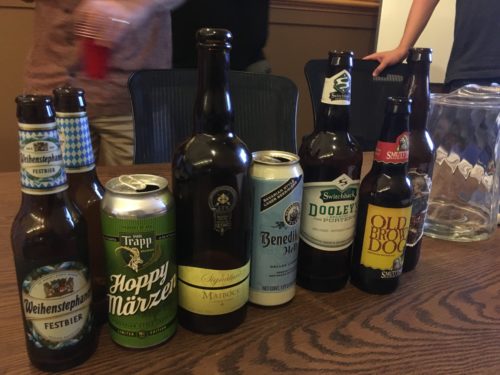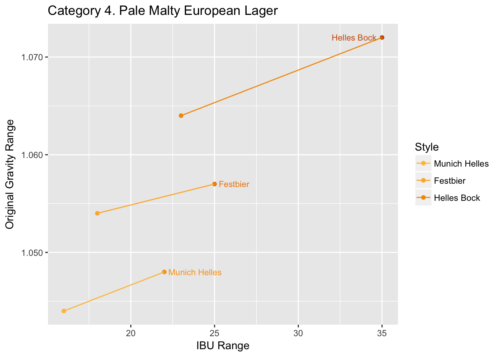BJCP Study Group: Category 4
¶ by Rob FrieselBJCP study group session number 10 convened around the Category 4 beers. But there was a little bit of a cliffhanger going into it as some last-minute shuffling happened when our scheduled coordinator had to back out. Nevertheless, we’re a scrappy and resourceful bunch, and we pulled it off with a complete complement.
For guest judges we were joined by Jason (our homebrew club president) and Amy (of Zymology Labs). No preambles about judging from either, we would get right into it.
Category 4: Pale Malty European Lager
The BJCP category description here goes:
This style category contains malty, pale, Pilsner malt-driven German lagers of vollbier to starkbier 1 strength. While malty, they are still well-attenuated, clean lagers, as are most German beers.
By and large, the category name says it all: the beers are pale, and the balance goes to the malt (but not without balancing bitterness) — and of course, it’s a lager with a smooth and clean fermentation profile. All three styles in the category should be well-attenuated, but not bone dry; none should have any caramel character. “Toasty” would be appropriate for any of them, though less so for Munich Helles. On any of the style, the hop character should be moderate at most, and most of the time it’s low to none. For the most part, these styles are pilsner powerhouses with some Vienna and Munich to develop the flavors and colors. Similar to the British Bitters, the styles are all fairly similar, mostly differentiated by alcohol and gravity, with the toasty character increasing alongside that, and the hop bitterness increasing to balance.
| 4A. Munich Helles | 4B. Festbier | 4C. Helles Bock |
|---|---|---|
| 16 – 22 IBU | 18 – 25 IBU | 23 – 25 IBU |
| 1.044 – 1.048 O.G. | 1.054 – 1.057 O.G. | 1.064 – 1.072 O.G. |
| 1.006 – 1.012 F.G. | 1.010 – 1.012 F.G. | 1.011 – 1.018 F.G. |
| 4.7 – 5.4% ABV | 5.8 – 6.3% ABV | 6.3 – 7.4% ABV |
And so we began with our scoresheets ready.
- 4A. Munich Helles. Benediktiner Hell/Original. Scored with structured tasting. Group scores were mostly in the mid-30s; a couple were in the high-30s, and as high as 40. Jason mostly directed the discussion toward those that had scored in the upper-range? “Why so high? How’d you land there?” There was some discussion around packaging and handling, which turned into a discussion about freshness. Further discussion about “low DMS” (and/but how “that’s OK for the style”.) For those of us in the mid-30s, the commonly cited flaws: some ester-derived character (grape?), not enough head retention, and the body was too light. From my own scoresheet: “Aromas and flavors, while not out of balance, did not fully marry and seemed like they could use a focus or a boost.”
- 4C. Helles Bock. Les Trois Mousquetaires Maibock. Scored with structured tasting. Corked 750 mL bottle. My first thought on this one: “Like a Belgian Golden Strong but… with lager yeast?” Most of the group scores were in the low to mid 30s; and likely those scores were on the high side. There was a lot of discussion around this beer, how there were so many little-to-moderate faults that all added up to a beer that was… while not unpleasant, not “Very Good” and certainly not to-style.
- Triangle Test. Dark beers; guess the odd beer out, guess the style(s). One pour of a American Porter, two pours of an American Brown Ale. Everyone successfully guessed the odd beer out, but no one nailed the style. I heard “Märzen vs. Schwarzbier” and “Porter vs. Stout” and “Munich Dunkel” — though at least one person had successfully called out down to the specific beer (Old Brown Dog) although not the other.
- Intermission. Some homebrews went around the room. Dan’s brown porter. Dan’s green tea IPA. Jason’s 6 year old guess-the-style mystery beer. 2
- 4B. Festbier. Weihenstephaner Festbier. Not scored. Side-by-side comparison of two samples; one fresh (June 2017) and the other over a year old. The fresher beer was much more rich, with more pronounced aromas and flavors. It was crisper and sweeter. The older sample? Obviously skunked. (“It’s 1986, and I’m sneaking sips off my uncle’s beer…”) The mouthfeel of the old beer seemed lighter; the color seemed stable.
- Bonus beer. Von Trapp Hoppy Märzen. Which was… not a Märzen. Not dark enough. Not malty enough. Not a full enough body. Hoppy as stated. But it didn’t feel balanced or refined. As at least one group member said: “Maybe there’s a reason that the Germans aren’t known for dry hopped beers?”
Takeaways
- Fill out the whole scoresheet! Jason glanced around the room at one point and reminded everyone: “If you have empty lines, think about what else you have to say about the beer.” A scoresheet should be very descriptive, and it should provide feedback, even tips on how to improve the beer. (Especially the latter.)
- Review the base flavors and be familiar with them. I had a bit of confusion during the Helles Bock about whether it had Maillard products or not. I didn’t think it had any. Then Jason was talking about them and I probed about the specifics. He cited them being “bready” and I looked back over my scoresheet where (indeed) I had jotted down “bready notes as it warms.” Which… I hadn’t made that connection before, and had always treated them differently, thinking Maillard as being more like… savory? or roasty? (Or maybe I’m just confusing Maillard with melanoidin? But aren’t those related?)
- For those that don’t speak German, these translate to “full beer” and “strong beer”, respectively.[↩]
- It was a “maple cream ale” where they’d used maple sap as the brewing liquor — but he called out this fact fairly soon after people had poured samples, so I’ll never know if I could have sussed out that maple on my own.[↩]
About Rob Friesel
Software engineer by day. Science fiction writer by night. Weekend homebrewer, beer educator at Black Flannel, and Certified Cicerone. Author of The PhantomJS Cookbook and a short story in Please Do Not Remove. View all posts by Rob Friesel →3 Responses to BJCP Study Group: Category 4
Pingback: BJCP Study Group: Category 19 (and/or Russian Imperial Stouts) | found drama


Leave a Reply